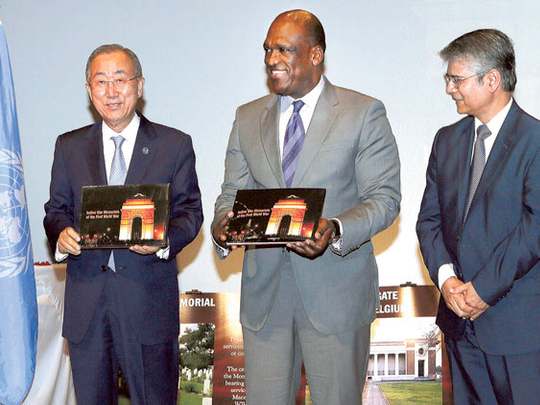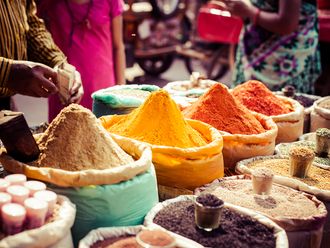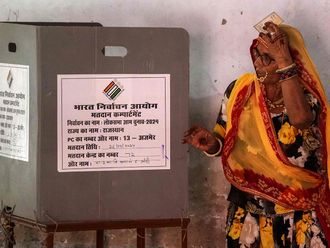
Few in India probably know that the remains of the thousands of Indian soldiers who made the “ultimate sacrifice” while fighting in the First World War for their British colonial masters lie scattered in many parts of the world.
This “ultimate sacrifice” is now being remembered not only by India but also other countries whose citizens also fought, like the Indian soldiers, under the Union Jack.
With unquestionable dedication and loyalty, nearly 1.3 million soldiers in the then undivided India set out to fight a war that was, clearly, not their own. Starting in 1914, the Indian army fought in the European, Mediterranean and the Middle Eastern theatres of war — the Indian army fought against the German Empire in German East Africa and on the Western front in Europe and its divisions also served in Mesopotamia (Iraq) against the Ottoman Empire.
There may have been different reasons behind the Indians enlisting to fight in the First World War. While money may have motivated many of the soldiers to join the British army to fight the war abroad — amusing as it may seem today, the average monthly pay of a “foot soldier” or a member of the infantry then was a meagre 11 rupees which today does not even fetch a cup of tea in an Irani restaurant in Mumbai — there were others who had different reasons for doing so. Indeed, many soldiers, motivated the possibility of India’s independence, believed that fighting for the British army would strengthen the cause of independence while others fought to thwart German rule which, they feared, would be worse than the British rule in India.
The British Indian army records recount countless tales of valour and gallantry — six Indian soldiers were awarded the Victoria Cross, the highest award in British military terms, for acts of bravery in the face of insurmountable danger.
The case of one Lance Naik Lala, who served in the 41st Dogra division, and was awarded the Victoria Cross, illustrates the bravery displayed in the so-called First Battle of Hanna in Mesopotamia. The citation that came with the award praises Naik Lala’s act of bravery: Besides dragging a wounded British officer of another regiment lying close to the enemy to a temporary improvised shelter, in which he had earlier bandaged four other wounded men, Naik Lala rushed to help the severely wounded adjutant of his own regiment who was lying in the open as the battle raged. This heroic act was carried out at great personal risk with the enemy only a hundred yards away. With his plea to carry the wounded adjutant on his back denied, Naik Lala offered his own clothing to keep the wounded officer warm, and stayed with the latter until it became dark so that he could return to the shelter to get a stretcher for transporting the adjutant. This act, according to the citation, was a “magnificent example of courage and devotion to his officers”. In his recollection before his death in 1927, Naik Lala said that he had “fought true”.
The sacrifices of the Indian soldiers in the First World War also prompted the UN to recently hold a special commemorative event at its New York headquarters.
Besides India, other permanent missions that co-hosted the event included those of Belgium, Egypt, France, Iraq, Jamaica, Kenya, Nigeria, South Africa and Tanzania; both the UN Secretary-General Ban Ki-moon, and the president of the 68th General Assembly, John Ashe, attended the event to highlight its significance.
The widespread destruction and the huge loss of human lives in the First World War had a major impact on the participants of the Paris Peace Conference of 1919, leading to the establishment of the world’s first multilateral organisation, the League of Nations. As a signatory to the Treaty of Versailles, India became a founder-member of the League of Nations, the precursor of today’s UN.
Ban and Ashe jointly released a publication called “Indian War Memorial of the First World War”, conceived and edited by India’s permanent representative to the UN, Ambassador Asoke Mukerji.
Obviously, keeping in mind the ongoing crises in Iraq, Syria, Gaza and other parts of the world, Ban admonished the audience “never to forget the roll call of carnage” of the First World War. Referring to the more than 62,000 Indian soldiers killed in action out of a total of nearly 1.3 million soldiers sent to the front, Ban said that “history often ignores such sacrifices”. The Indian soldiers died with many others from Africa, Asia and Europe.
“Let us also remember that although the so-called Great War was fought in Europe, soldiers came from all over the world,” Ban said.
Ban recalled the words of an Indian soldier writing home in early 1915: “The bullets and cannon balls come down like snow. The mud is up to a man’s middle. The distance between us and the enemy is fifty paces … the numbers that have fallen cannot be counted.”
While releasing the publication, Ban described memorials as “points of pilgrimage” and fitting tributes to valour and sacrifice”.
The event at the UN on August 14 coincided with the centennial of Mahatma Gandhi writing the historic letter to the British government. The letter contained his famous words that India’s assistance to the war effort was guided by the desire “to share the responsibilities of membership of this great empire, if we would share its privileges”.
Apparently inspired by Gandhi’s thoughts, Indian Ambassador Mukerji told Weekend Review on the sidelines of the event that “a hundred years later, it can be said that this same sentiment prevails among the vast majority of the membership of the United Nations, who have been willingly sharing in the responsibilities of this unique organisation in the hope that they would be allowed to share in its privileges as well”.
The permanent representatives of the other nine countries also made brief remarks at the event, highlighting the sacrifices of soldiers and the horrors of war. But, perhaps, the most poignant remarks came from Nafsika Nancy Eva Vraila, Greece’s deputy permanent representative, when she revealed the existence of an Indian cemetery in the Greek town of Thessaloniki.
“This cemetery does not resemble any other in Greece, because people of different religions are almost always buried in separate cemeteries, and Hindu cemeteries do not exist [because Hindus cremate their dead]. In the Indian cemetery of Thessaloniki, however, Indians, regardless of their religion — Hindus, Muslims, Sikhs and Christians — all rest in peace together. From the historical data at our disposal the fallen Indians served in 36 different Anglo-Indian military units, mainly with the Royal Field Artillery, the Transport Corps of Holkar, Bharatpur and Indore, the Mule Corps and, after 1918, certain Indian regiments. They came mainly from ‘martial races’ as the British named them: Sikhs from Punjab, Rajputs from Rajasthan, Jats from the northwest, Gurkhas from Nepal,” she said.
Greece, she said, paid respect to those Indians who “made the ultimate sacrifice for Greece and Europe’s freedom, and who form one more link in the long chain of Greek-Indian relations which go as far back as the Persian wars and Alexander the Great”.
Manik Mehta is a commentator on Asian affairs.












